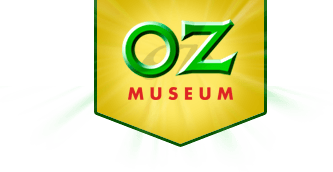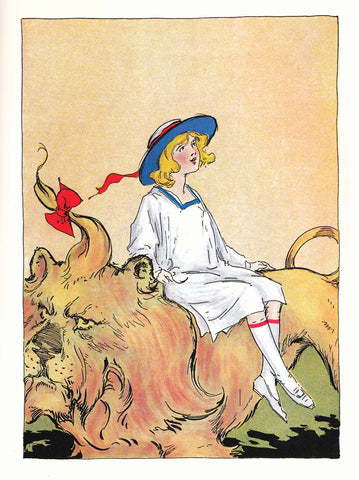 VISIT
MUSEUM STORE
MEMBERSHIP
OZ NEWS
CONTACT
VISIT
MUSEUM STORE
MEMBERSHIP
OZ NEWS
CONTACT
Judy & Mickey & OZ…Oh, My! -- Part One
Aug 22, 2014
Judy & Mickey & OZ…Oh, My! -- Part One

Had you been in New York City seventy-five years ago this week – or actually at any time between August 17th and September 6th, 1939 – you could have seen Metro-Goldwyn-Mayer’s Technicolor musical extravaganza, THE WIZARD OF OZ, in its exclusive Broadway debut at the Capitol Theatre.
Ah, for a time machine!
That may be a cliché, but it’s far from an idle wish. As it turned out, anybody at the Capitol across those three weeks got much more for their money than even the unforgettable glories of a soon-to-be classic movie.
Back in the day, The Capitol was one of Manhattan’s “deluxe picture palaces,” located on the southwest corner of Broadway and 51st Street. It had been built in 1919 to exhibit the ever-greater glories of the silver screen -- and then personally accessed five years later by Loew’s, Inc., the NYC-based parent company of M-G-M. They established it as one of their own flagship venues; its lavish, luxurious interior could seat nearly five thousand patrons at a time. Across those early years of operation, the Capitol often augmented its program with live stage shows, performed four or more times per day between film screenings. That combination was abandoned circa 1935, and the theater continued solely as a preeminent cinema. Four years later, however, Metro and Loew’s reconnoitered and decided to revive the concept so as to most effectively launch THE WIZARD OF OZ in America’s major metropolis.
In other words, had you been in New York City seventy-five years ago this week, you could have gone to The Capitol Theatre – for much less than a dollar in change. You would have enjoyed THE WIZARD OF OZ, first run, for the first time, on a huge screen. You would have seen the customary short subjects and “trailers.” And after that two-hours-plus of extraordinary entertainment, you would have seen the Capitol movie screen withdraw to reveal a twenty-one piece orchestra, fronted by M-G-M’s ace conductor Georgie Stoll. You would have seen -- and heard -- a superlative eight-voice chorale (“The Martins”) offering a fresh, stylish vocal arrangement of that new song hit, “We’re Off to See the Wizard.”
And then, for the next twenty-five minutes, you would have seen -- “live!” and “in person!” -- Judy Garland and Mickey Rooney: singing, dancing, chatting, and clowning together on the Capitol stage.
If that sounds pretty extraordinary in retrospect, it’s absolutely nothing compared to the reality of the occasion at the time. Had you been in New York City seventy-five years ago this month, you would have witnessed what was eventually summarized as the greatest Big Apple reception ever provided Hollywood stars to that date – by the media, by the kids’ coworkers, and (especially) by the public.
Here’s some contemporary perspective:
Mickey Rooney then was the number-one box office sensation of motion pictures – a position he would hold again in 1940 and 1941. After her success in OZ and their next film together, BABES IN ARMS, Judy Garland would join him on that annual list of the “top ten” movie stars. Such recognition was, of course, a natural byproduct for the rarefied few who were more than rapturously embraced by the film-going public. But in the case of the Capitol Theatre appearance, M-G-M was vastly helped in their exploitation of Judy and Mickey by the fact that the stage -- not the screen -- was the kids’ original habitat. Starting at age two, both had grown up in minor and then major theaters as vaudeville players. By August 1939, Rooney was barely nineteen and Judy had just turned seventeen, yet they were show business veterans, sharing between them something over thirty years of performing experience.
It was that caliber of professionalism, of course, that led to their film careers. By the time they hit the Capitol stage, Judy and Mickey had achieved rank as the very first teen team of screen superstars – an achievement based on much more than mere name and image. If their stardom was, indeed, studio-crafted and studio-hyped, it also was solidly founded on genuine, charismatic, and God-given talent. The New York theater critics of August 1939 were quick to concur. VARIETY then was considered the “Bible” of the entertainment industry trade-papers and reviewed Rooney and Garland at the Capitol as “young, fresh, and on the up-beat in the public’s affection and imagination – a tousle-haired imp and a cute clean-cut girl with a smash singing voice and style. It’s grade-A showmanship by both kids.” The diverse New York daily press agreed, heralding the youngsters as “nothing short of terrific” and praising them for “all the verve and rhythmic bounce of youth” and “a bang up” job. (The New York HERALD TRIBUNE was perhaps more subdued but willingly acquiesced, “If Hollywood must come ‘in person,’ this is the way it should do it.”)
The media was clearly delighted, but their thrill was no more than that shared by two talents new to the Garland/Rooney orbit. “The Martins” vocal group was spearheaded by Hugh Martin and Ralph Blane, boy singer/musicians from, respectively, Alabama and Oklahoma. The duo had already performed on the New York stage, and both would come to enjoy enormous success as songwriters. (In the next few seasons alone, they would write the score for the Broadway hit, BEST FOOT FORWARD, and the new songs for Judy’s M-G-M classic, MEET ME IN ST. LOUIS.) But when he remembered August 1939 in a 1996 interview, Martin’s point of view was that of a young man from Birmingham who was much more theater and radio-oriented than motion picture and Hollywood-savvy. As he admitted, "I wasn't even aware of Judy Garland at that point, and when we came to [The Capitol to] rehearse, I was in the wings and listened to her sing 'The Lamp is Low.' And we all stood there, riveted -- everyone connected with the show...this glorious voice coming out of this little girl. We couldn't believe it; it was like a miracle. And there were a lot of tears; she really, absolutely pulverized us.”
In a 1939 fanzine article, Blane offered the same type of fervor and added a personal “take” as well: “I can't tell you the thrill at discovering [Judy and Mickey] were two of the nicest kids you'd ever care to know. They were perfect: a lady and gentleman. I think we had just as much fun onstage watching these brilliant performers as the audiences did...the two most famous kids in the world."
As professionals themselves, Garland and Rooney obviously were capable of charming other pros and the press. There was no heavy gamble in bringing them to New York on that level. Indeed, the major question at hand came with Metro’s concern as to whether the couple’s public draw “in person” would equal their screen appeal, so as to pull in an absolutely essential audience for the way-over-budget, three-million dollar WIZARD OF OZ. As a result, M-G-M left nothing to chance; advance OZ promotion had been rampant all summer, and mass publicity for the teens’ Manhattan appearance began nearly two weeks prior to the Capitol opening.
For additional insurance, Garland and Rooney spent August 9th, 10th, 11th, and 12th on the road, “breaking in” their act with one-day stands in Washington, D.C., and in Bridgeport, New Haven, and Hartford in Connecticut. They did multiple, sold-out performances in each playhouse; many people had to be turned away. All of this was much more than promising, but the first real test of the kids’ appeal to New York City would come with their arrival in Manhattan on August 14th.
By 1939, Loew’s, Inc., and M-G-M were hardened veterans at arranging “spontaneous” receptions -- of almost any size, anywhere -- for their new films and visiting stars; OZ, Judy, and Mickey warranted a full-force operation. The studio offices organized an official welcoming committee by sponsoring a contest in which the names of one hundred and fifty teenagers were drawn from specially-installed ballot boxes in the lobbies of Loew’s movie theaters throughout the greater New York and New Jersey areas. Some two hundred and fifty thousand submissions were received, and the selected seventy-five girls and seventy-five boys rallied, as directed, on Broadway near Times Square on that hot, humid Monday morning. They then were provided with signs, banners, buttons, ribbons, and high paper hats and led by a marching band to Grand Central Station. It promised to be a dazzling and impressive salute to the Garland/Rooney twosome.
But no one was prepared for what actually greeted the stars when they got off their train from Connecticut. There were, of course, the Loew’s-sponsored musicians, the carefully-staged committee group, and the expected newspaper, magazine, and newsreel reporters and photographers.
Beyond all of that, however, was an additional group of anticipatory, waiting fans.
Ten thousand anticipatory, waiting fans.
[to be continued]
Article by John Fricke



